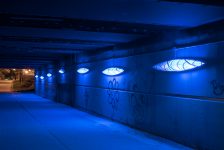Light Canoes is a light installation designed by Maha Mustafa. Rather than use traditional underpass lighting during this development Mustafa was commissioned to create an artwork that both illuminated the space and expressed a narrative. Mustafa’s use of blue light represents the waterfront just south of the underpass. By bathing the space in blue, Mustafa calls back to a time when the entire area of the city was underwater. The lights take the shape of canoes, which represent the previous forms of travel in the area of the city, a stark contrast to the roadways that cross above the artwork.
Audiences can access this piece from the rail way walking path.


